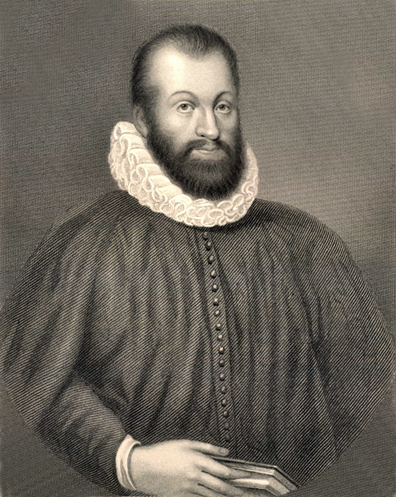George Wishart

Engraved from the original in Glasgow University
Scottish Protestant Reformer, martyred in 1546AD.
GEORGE WISHART, the Scottish martyr, was the son of a country gentleman, the laird of Pittarrow in Mearns, and was born about the beginning of the sixteenth century. Nothing is known of his early years. He first appears as a teacher of Greek at Montrose; but he was soon obliged to leave the country, in consequence of a threatened prosecution by Hepburn, bishop of Brechin, for instructing his pupils in the Greek Testament.
He is next heard of in Bristol, where he became is preacher, and was brought before the ecclesiastical authorities and condemned as a heretic, on account of his denunciations of the worship paid to the Virgin. His confidence in his opinions at this period does not appear to have been strong, for he recanted, and burned a faggot in the church of St. Nicholas. He then went abroad, and spent some time in Germany and Switzerland. On his return he entered Corpus Christi college, Cambridge, where he diligently prosecuted his own studies, and faithfully superintended the studies of others. One of his pupils, Emery Tylney—who has given a graphic portrait of Wishart’s appearance and manners, as a “man of tall stature, black-haired, long-bearded, comely of personage, well spoken after his country of Scotland, and courteous, lowly, lovely, glad to teach, and desirous to learn”—bears affectionate testimony to his piety, self-denial, and extra-ordinary charity and kindness to the poor.
In 1543 Wishart returned to his own country, in company with the commissioners who had been sent to conclude the treaty between England and Scotland, and preached with great earnestness and success in Montrose and Dundee, and their neighbourhoods. In consequence of the opposition of the Romish party, he was compelled to withdraw from Dundee, and proceeding to the west country, preached to great multitudes in Ayr, and the other principal towns in that district. Intelligence having reached him that the plague had broken out in Dundee, he immediately returned to that place, and remained there ministering both to the spiritual and temporal necessities of the afflicted, until the pestilence had almost wholly disappeared.
He next proceeded to Montrose, and then turning his steps southward, preached in Leith, Inveresk, and Haddington. Knowing well the inveteracy of his enemies, and especially of Cardinal Beaton, whose influence was now paramount in the country, Wishart seems to have had a premonition that his end was not far off; for on leaving Haddington he said to John Knox, who was preparing to accompany him as usual, “Nay, return to your pupils; one is enough at this time for a sacrifice.”
A few days later, he was arrested at Ormiston house during the night by the earl of Bothwell, who however pledged his honour for the safety of Wishart’s person. But the cardinal and queen-dowager prevailed upon the earl to violate his pledge, and to deliver his prisoner into the hands of Beaton, who confined him in the castle of Edinburgh, and a few days later had him transferred to St. Andrews. No time was lost in bringing Wishart to trial, and through the earl of Arran, regent of the kingdom, refused his sanction, the cardinal proceeded with the case on his own authority.
Wishart denied the competency of the court before which he was brought (28th February, 1546), and appealed to the lord-governor as supreme authority in the kingdom, but his appeal was disregarded. Eighteen charges were brought against him, relating to the number of the sacraments, auricular confession, extreme unction, prayer to saints, the marriage of priests, and other dogmas of the Romish church; and though he made a vigorous and impressive defence, he was of course found guilty, and condemned to be burned. His execution took place on the following day (March 1st), in front of the castle of St. Andrews; and the cardinal who had previously forbidden by proclamation any person to pray for the heretic, under pain of the severest censures of the church, caused the guns of the castle to be directed towards the scaffold, lest any attempt at rescue should be made.
Wishart bore his agonizing sufferings with great fortitude, and died expressing his confident hope of a reward in heaven. There can be little doubt that the public indignation excited by his martyrdom, contributed to hasten both the death of Beaton, and the downfall of popery in Scotland. It has been alleged that Wishart was a party to the plot against the cardinal; but the evidence adduced to prove this assertion is of the most trifling character.—J. T.
[from "The Imperial Dictionary of Universal Biography" 14 vols., published between1878-1880AD)]
George Wisehart (198k) pdf (94k) docx (41k) by John Foxe, from his Acts & Monuments, volume 5, 1838AD edition
George Wishart (131k) pdf (79k) docx (34k) by Rev. Erasmus Middleton from his "Evangelical Biography..." volume 1. 1816AD